Outreach
We participate in many activities involving the community — scientists or non-scientists, we are happy to share our nerdiness!
The journal of the Biochemical Society (UK) published a short, simple review that outlines our research.
What We Do
How do you manage a school’s cafeteria that serves breakfast, lunch, and dinner to hundreds of students? How do you account for different diets and for the fact that one day, there is a big fire in the kitchen? – These are questions that we do not answer in my lab. But we try to answer similar questions: How does the cell, as a system, ‘cook up’ and degrade thousands (if not millions) of different protein molecules every single day. How are the different steps coordinated. How does the cell adjust protein production if there are unexpected perturbations. Similar to a cafeteria, there is a big cookbook (the DNA) from which the cell takes notes (the RNA molecules) and ‘cooks’ the final product (the proteins). Each human cell knows about 20,000 different ‘recipes’, and my lab aims to detect the rules that govern protein synthesis.
We study these rules using a scale. This scale is a high-precision instrument, called mass spectrometer, and it can measure the masses of molecules. From these masses we determine which protein molecules were present at what time and what concentration. Hemoglobin for example, has a very specific mass fingerprint different from that of insulin. Then we perturb the cells, we subject them to stress. These stressors can be chemicals, for example those that mimic the effect of too much sunshine or car exhaust, or they mimic a fire. We watch how the cells divide under stress or how they stop dividing, and we examine how they respond by adjusting the production and degradation of protein molecules. What makes my lab unique is that we study all these different processes in one system, we examine both synthesis and degradation of molecules, we conduct experiments and create computational models of the data – in order to derive and test hypotheses on rules that govern this cellular ‘cafeteria’.
Many years of evolution created various processes that protect the cells from such stress to restore the balance of protein production and a ‘normal’ state. These anti-stress processes reverse damage or degrade irreparable molecules. When cells age, however, they lose the ability to respond to stress in an appropriate way and damaged molecules accumulate. The accumulation of this ‘garbage’ is highly toxic, particularly for the neurons in our brain, as they cannot be replaced – and subsequently we develop age-related diseases such as Alzheimer’s or Parkinson’s disease that are marked by toxic protein aggregates. Therefore, understanding the cellular stress response and the role of protein synthesis helps us understand how the cell helps itself in an emergency, and perhaps, will enable us to repair damaged cells and restore proper function.
CURRENT OUTREACH ACTIVITIES
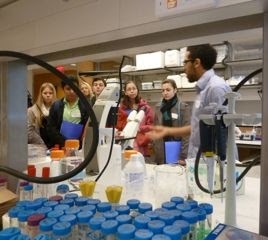
1. Johns Hopkins Center for Talented Youth — Annual visit to NYU’s Center for Genomics and Systems Biology
For the last three years, we have been co-hosting the NYU Activity Day for the Johns Hopkins Center for Talented Youth. Each year, it’s been a day of science and fun, listening, trying out, and getting to know our daily research lives. Last year we had a record of >80 visitors who include middle- and high-school students and their parents. In addition to listening to lectures given by faculty from our department, our visitors have the chance to see real cancer cells growing in a dish, yeast cells and their changing looks when being happy or stressed, and the mass spectrometer, our ‘magic’ machine that allows us to measure very very tiny masses of very very tiny protein molecules. Everyone learns what Manhattan’s traffic and a gigantic scale have to do with our work, and hopefully leaves the lab wanting to become scientists — like us!
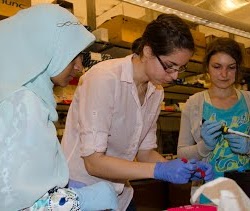
2. NYU Poly Center for K12 STEM Education — ARISE Program
For the last two years, we have also participated in the NYU Center for K12 STEM Education’s summer program called ARISE which stands for Applied Research Innovations in Science and Engineering. Each time, we host at least two highschool students who, over the course of eight weeks, work with us on a research project. These projects are chosen not just to teach the students how research works, they are also part of our ongoing quest to discover new things! This year, for example, our students investigated dividing cells, and whether the proteins in these cells are marked by a certain signal which we recently discovered! Exciting work — and during the final presentations, our students did an amazing job. Well done!
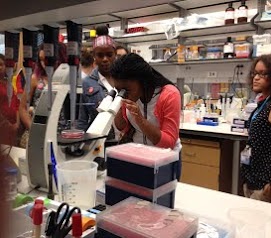
3. World Science Festival — NYU
The World Science Festival held each summer near Washington Square Park is famous — not only at NYU, but across the entire city. This year we participated in the Girls in Science program and led groups of 40 visitors through our lab. The visitors had a unique chance to see our work environment, see us (women in science!) in full action, and learn everything about a career in academia.
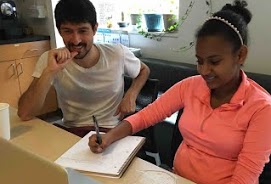
4. NYU Courant GSTEM Program for Gifted Girls
The program invites young women to explore STEM fields, to learn programming and mathematical concepts. Christian from Ethiopia spent six weeks in our lab, working with Kostya on a project to understand more about mammalian gene expression regulation.
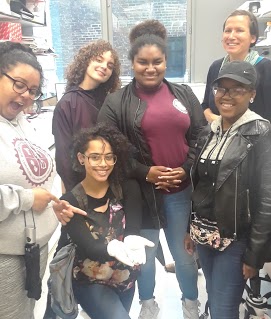
5. Forsyth Satellite Academy at NYU
Students from Forsyth Satellite Academy, a Transfer High School in Manhattan, visited in 2017 and 2018 to talk about HeLa cells and how we use them in the lab to understand the response to stress.